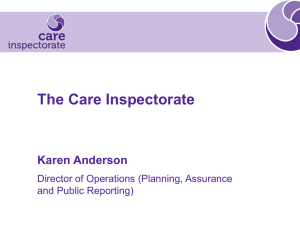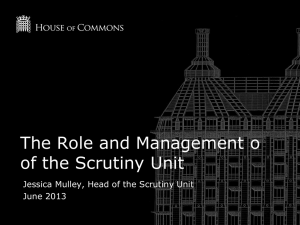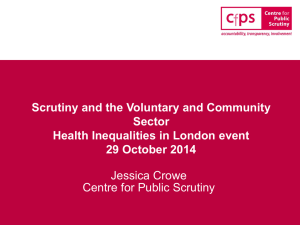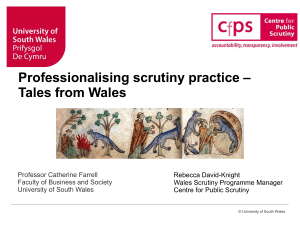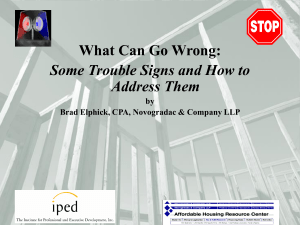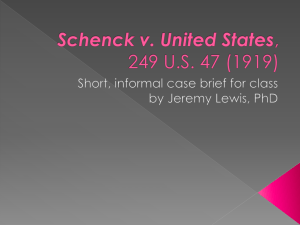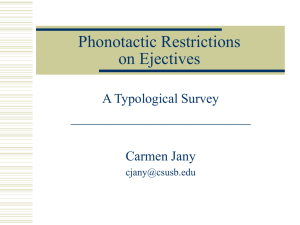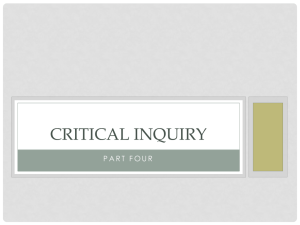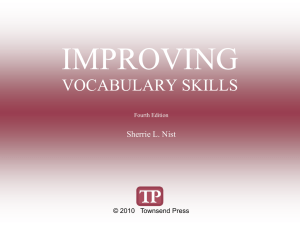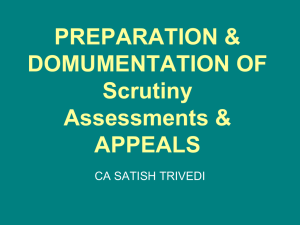Freedom of Speech and Press
advertisement
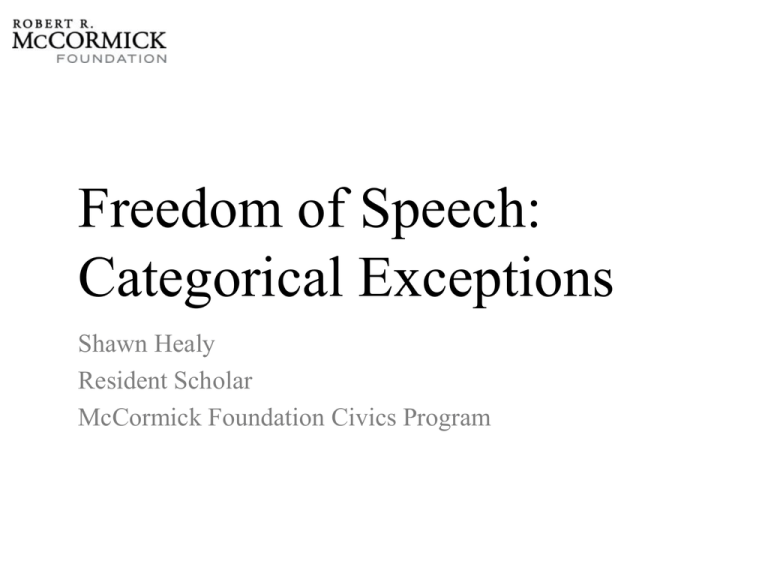
Freedom of Speech: Categorical Exceptions Shawn Healy Resident Scholar McCormick Foundation Civics Program Overview: Freedom of Speech and Press “Congress shall make no law respecting an establishment of religion, or prohibiting the free exercise thereof; or abridging the freedom of speech, or of the press; or the right of the people peaceably to assemble, and to petition the government for a redress of grievances.” 2 Freedom of Speech: Categorical Exceptions • Not protected by the First Amendment: -Defamation: Actual malice, knowingly false charges, and reckless disregard for the truth Controlling case: New York Times v. Sullivan (1964) -Incitement: Imminence between the call for action and the action itself Controlling case: Brandenburg v. Ohio (1969) -Fighting words: Spoken words that instigate violent reactions Controlling case: Chaplinsky v. New Hampshire (1942) -True Threat: Distinguish true threats from political hyperbole Controlling case: Watts v. United States (1969) -Obscenity: Apply three-part Miller Test Controlling case: Miller v. California (1971) 3 Categorical Exceptions: Incitement An historic progression of free speech tests: • Bad tendency -Rooted in English Common Law and articulated in Gitlow v. New York (1925) • Clear and present danger -First articulated by Holmes in Schenck v. U.S. (1919), and adopted by a majority of the Court in Herndon v. Lowry (1937) • Imminent lawless action -Supplants clear and present danger test in Brandenburg v. Ohio (1969) -Exception: speech cases in military courts Incitement: Bad Tendency Test World War I: Used as test to determine whether speech critical of government during the war and its aftermath crossed the line Sedition Act of 1917: • Congress intended to forestall threats to military operations • The Wilson Administration used to prohibit dissenting views • Shaffer v. U.S. (9th Circuit Court of Appeals): “It is true that disapproval of war and the advocacy of peace are not crimes under the Espionage Act; but the question here is…whether the natural and probable tendency and effect of the words…are such as are calculated to produce the result condemned by the statute.” Incitement: Bad Tendency Test (Cont.) Abrams v. U.S. (1919): • Pamphlet critical of Wilson’s decision to send troops to Russia, urging U.S. workers to strike in protest • Charged under 1918 amendment to Sedition Act prohibiting expression of disloyalty and interference with the war effort • Downplayed clear and present danger distinction: “for the language of these circulars was obviously intended to provoke and to encourage resistance to the United States and the war.” Incitement: Bad Tendency Test (Cont.) Gitlow v. New York (1925): • Socialist Benjamin Gitlow distributed a flyer calling for mass insurrection and the overthrow of the capitalist system, violating New York’s criminal anarchy statute • Conviction upheld under bad tendency test • Freedom of speech and press incorporated to the states Whitney v. California (1927): • Charlotte Anita Whitney is arrested for her membership in communist and socialist organizations that helped to form the Communist Labor Party • She was charged under California’s criminal syndicalism laws, and the Supreme Court rejected her free speech claims • “A state in its exercise of police power may punish those who abuse this freedom by utterances inimical to the public welfare, tending to incite crime, disturb the public welfare, or endanger the foundations of organized government and threaten its overthrow by violent means.” Incitement: Clear and Present Danger Test Schenk v. U.S. (1919): • Justice Holmes: “The question in every case is whether the words used are used in such circumstances and are of such a nature as to create a clear and present danger that they will bring about the substantive evils that the United States Congress has a right to prevent. It is a question of proximity and degree. When a nation is at war, many things that might be said in time of peace are such a hindrance to its effort that their utterance will not be endured so long as men fight, and that no Court could regard them as protected by any constitutional right.” Incitement: Clear and Present Danger Test Abrams v. U.S. (1919): • Holmes found Schenk test insufficient in dissent: “We should be eternally vigilant against attempts to check the expression of opinions…unless they so imminently threaten immediate interference with the lawful and pressing purpose of law that an immediate check is required to save the country.” • Brandeis, joined by Holmes: “evil apprehended” should be “so substantial as to justify the restriction apprehended by the legislature.” Incitement: Clear and Present Danger Test Herndon v. Lowry (1937): • Justice Owen Roberts rejected bad tendency test in favor of clear and present danger • Employed by Court in 12 cases following Herndon through 1951 • Freedom of assembly incorporated to the states Dennis v. U.S. (1951): • Judge Learned Hand, embraced by Chief Justice Vinson: “Clear and present danger depends upon whether the mischief of the repression is greater than the gravity of the evil, discounted by its improbability.” • The clear and present danger distinction became blurred and essentially gave carte blanche to all legislative infringements on free speech. Incitement: Clear and Present Danger Test Brandenburg v. Ohio (1969): • Facts of the case • Issues/ decisions • Reasoning • Separate opinions • Discussion Categorical Exceptions: Obscenity Obscenity and Pornography: How are the two distinguished? Does the First Amendment protect both? Pornography Obscenity Evolving Case Law: • Regina v. Hicklin (1868, British case): “whether the tendency of the matter…is to deprave and corrupt those whose minds are open to such immoral influences, and into whose hands a publication of this sort may fall.” • Roth v. U.S. (1957): “Obscenity is not within the area of constitutionally protected speech…” The test followed, and read: “Whether to the average person, applying contemporary community standards, the dominant theme of the material taken as a whole appeals to the prurient interest.” Categorical Exceptions: Obscenity Evolving Case Law: • Jacobellis v. Ohio (1964): “I know it when I see it.” —Justice Potter Stewart • Memoirs v. Massachusetts (1966): Memoirs of a Woman with Pleasure was not "utterly without redeeming social value." The Court confirmed that books could not be considered obscene unless they were completely worthless, even if they possessed prurient appeal and were "patently offensive." • Interstate Circuit, Inc. v. Dallas (1968): The ‘intractable obscenity problem.”—Justice John Marshall Harlan II Categorical Exceptions: Obscenity Miller v. California (1971): • Facts of the case • Issues/ decisions • Reasoning • Separate opinions • Discussion Categorical Exceptions: Obscenity Group Exercise: 1. Review the fact pattern of the assigned Supreme Court or federal court case and apply the three-pronged test for obscenity developed in Miller v. California (1971): A. Paris Adult Theater v. Slaton (1973) B. New York v. Ferber (1982) C. American Booksellers Association, Inc. v. Hudnut (1985) D. Pope v. Illinois (1987) E. National Endowment for the Arts v. Finley (1998) F. Ashcroft v. Free Speech Coalition (2002) 2. In what ways, if any, is the Miller test inappropriate for the case you are considering? 3. How might you suggest that the Miller test be modified? 4. Report your findings to the class Freedom of Speech: Categorical Exceptions Questions? Freedom of Speech: Tiers of Scrutiny Shawn Healy Resident Scholar McCormick Foundation Civics Program Freedom of Speech and Press • Tiers of constitutional scrutiny -Strict scrutiny: Pure speech Controlling case: Rosenberger v. Rector and Visitors of the University of Virginia (1995) -Intermediate scrutiny: Speech plus Controlling case: United States v. O’Brien (1968) -Reasonableness: Content-neutral time, place, and manner restrictions Controlling case: Ward v. Rock Against Racism (1989) Strict Scrutiny High Intermediate Scrutiny Reasonableness Low 18 Tiers of Constitutional Scrutiny: Strict Scrutiny Pure Speech: • Forcing an individual to articulate or disseminate the government’s message • Compelling an individual to disclose his or her position on an issue • Viewpoint or content-based discrimination • Regulation aimed at the suppression of expression • Regulation of expression in a public forum other than content neutral time, place, and manner restrictions Test: 1. Regulation is presumptively unconstitutional and the government must establish its constitutionality 2. The government must establish a compelling interest 3. The government must show that the regulation is the least restrictive alternative Tiers of Constitutional Scrutiny: Intermediate Scrutiny Speech Plus: • Combination of speech and non-speech elements 1. There is an intent to deliver a message 2. It is likely that the message will be understood by the intended audience • If both of these conditions are not met, this activity is not considered expression and therefore falls into the lowest tier of scrutiny Test: Government regulation is permissible when… 1. It is within the constitutional power of government 2. It furthers an important or substantive government interest 3. The regulation is not related to the suppression of expression 4. The incidental impact on expression is no greater than necessary to further that interest Intermediate Scrutiny: Speech Plus U.S. v. O’Brien (1968): • Facts of the case • Issues/ decisions • Reasoning • Separate opinions • Discussion Intermediate Scrutiny: Speech Plus Texas v. Johnson (1989): • Gregory Lee Johnson joined a protest at the 1984 Republican National Convention in Dallas where he burned an American flag at the end of a march. • Convicted under a Texas law that prohibited defacement of damage to the American flag with knowledge that it will “seriously offend one or more persons likely to observe or discover his action.” • Sentenced to one year imprisonment, and appealed on First Amendment grounds, claiming his actions were a symbolic form of free speech. • Can a state punish acts of flag desecration with criminal penalties? • Does the free speech clause of the First Amendment protest those who would destroy our national symbol? Intermediate Scrutiny: Speech Plus R.A.V. v. St. Paul (1992): • RAV (Robert A. Viktora) and several other teens constructed a cross out of broken chairs and burned it in the yard of an African-American family. RAV was charged with delinquency under a city ordinance that punished hate crimes. • The Bias Motivated Crime Ordinance read in part: “Whoever places on public or private property a symbol, object, appellation, characterization, or graffiti, including, but not limited to, a burning cross or Nazi swastika, which one knows or has reasonable grounds to know arouses, anger, alarm, or resentment in others on the basis of race, color, creed, religion, or gender commits disorderly conduct and shall be guilty of a misdemeanor.” • Does the ordinance encompass content-based discrimination, or is it within the categorical exception for fighting words? Intermediate Scrutiny: Speech Plus Virginia v. Black (2003): • Concerned a Virginia statute that prohibited public cross burnings with the intent to intimidate others; intent was determined by a jury • O’Connor wrote for a 6-3 majority, calling cross burnings a “true threat,” another categorical exception to freedom of speech (Watts v. United States (1969)) • How does this square with RAV v. St. Paul? -Exception built into ruling that allowed states to ban extreme forms of proscribe speech while tolerating less severe forms • The Court did strike down the jury’s ability to determine intent, suggesting that a cross burned on a family’s front lawn may be a product of anger rather than intent to intimidate • However, the cross burned at a KKK rally was intended to intimate Intermediate Scrutiny: Speech Plus Barnes v. Glen Theatre (1991): • Darlene Miller was a “go-go” dancer at the Kit Kat Lounge in South Bend, IN. Gayle Sutro danced in a coin-operated booth at the nearby Chippewa Bookstore.. • Both women were required to wear pasties and g-strings under Indiana’s indecency law. They shed both in order to attract tips and higher drink sales. • They sued the crusading county prosecutor, Michael Barnes, who had raided clubs with nude dancers. • Did the Indiana law infringe on their First Amendment right to express an erotic message? • Is it in the state’s interest to prevent nude dancing as a gateway to prevent prostitution and other social evils? Tiers of Constitutional Scrutiny: Reasonableness Public Forum Analysis: • Traditional Public Forum: Existed since “time of mind, “ i.e., a public park—content based restrictions highly suspect • Limited (or Designated) Public Forum: Established by government policy and practice; they may be limited to the class of content for which the forum is established—time, place and manner restrictions are permissible, but content based restrictions must be narrowly drawn and serve a compelling state interest • Nonpublic Forum: Regulation must be reasonable and not an attempt to silence expression because public officials oppose the speaker’s view Reasonableness: Time, Place and Manner Restrictions Ward v. Rock Against Racism (1989): • Facts of the case • Issues/ decisions • Reasoning • Separate opinions • Discussion Reasonableness: Time, Place and Manner Restrictions Content-Neutral Time, Place and Manner Restrictions in a Public Forum: Test: Government may impose generally applicable, reasonable time, place and manner restrictions when… 1. The regulated speech is not content-specific 2. The restrictions are narrowly-tailored and serve a significant government interest 3. The restrictions leave ample alternative means to convey the message Reasonableness: Conduct Expression in a Nonpublic Forum: Test: Reasonableness… 1. The burden is on the attacking party to show that the regulation is arbitrary 2. The test is met if there is a reasonable connection between the policy the government has chosen and the problem it is intended to address 3. The policy need not be the best alternative, but merely a reasonable one 4. Does not trigger First Amendment scrutiny, but may be challenged on due process grounds, specifically on the basis of vagueness, where a reasonably intelligent person has adequate notice of what the statute prohibits Reasonableness: Time, Place and Manner Restrictions Group Exercise: 1. Review the fact pattern of the assigned Supreme Court case and apply the three-pronged test for time, place and manner restrictions to determine the constitutionality of the regulation under scrutiny 2. If the said regulation fails any part of the test, how can it be modified to satisfy all three prongs? 3. Construct a model policy that meets the time, place and manner test for one of four assigned government restrictions on expressive activities 4. Report your findings to the class Freedom of Speech: Tiers of Scrutiny Questions?
